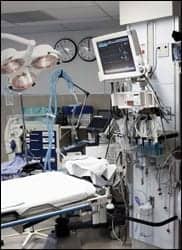This article will begin a two-part series that will look at several types of infusion management devices and the information one must possess to do well on the CBET exam.

Infusion pumps, or volumetric pumps, are associated with administering medication or fluids at a set rate. Most technicians in the field are very proficient in the maintenance of these devices, as most hospitals have many units and they are in heavy demand. However, when one is preparing for the CBET exam, one must be mindful of the other types of pumps. Other infusion management devices you could likely see on the exam are patient controlled analgesic (PCA) pumps, syringe pumps, feeding pumps, and ambulatory pumps. These devices deliver medication, nutrition, and hormone drug therapies. Most pumps use a delivery mechanism known as peristaltic, worm gear, or piston action to accurately deliver prescribed dosages to the patient.
Most standard intravenous pumps found on the market today use the piston or linear peristaltic delivery mechanism and a specific tubing set or cassette set to achieve accurate delivery. In linear peristaltic-type pumps, fingers or cams are located on a camshaft. As the shaft rotates, each “pinched off” section of the tubing delivers its set volume to the patient. The volume of solution between the fingers on the camshaft will determine the amount of solution administered. The speed at which the camshaft rotates will dictate the volume infused over a period of time.
In the piston-type pump, a specific cassette must be used to achieve accurate delivery because the set volume of the solution in the cassette chamber delivers a predetermined amount of solution. The rate at which the piston pushes against the cassette will determine the volume infused over a period of time.
Accurate Delivery
As stated, correct cassette sets and tubing sets must be used for the device to perform accurately. For example, if you used a tubing set with a peristaltic pump, and the tubing’s internal diameter was bigger than what the pump was manufactured for, the patient could be overinfused. The same would apply to a cassette if the cassette’s reservoir were larger than what the pump was manufactured for. This could be a prime example of a CBET exam question.
Syringe pumps, which encompass PCA pumps or epidural pumps and what is referred to as an anesthesia pump, work on delivery systems, which are based on the principle of a worm gear. This type of pump is employed when smaller volumes of a solution will be administered to the patient. The plunger of the syringe is attached to a moving carriage, which is attached to a rotating “screw” assembly. As the “screw” turns, it moves the attached carriage, which pushes the syringe plunger and the solution is administered to the patient. The speed at which the screw turns will determine the rate at which the solution is delivered to the patient. Programming of the pump for proper syringe sizes is critical for proper function, just as the tubing and cassettes are for the previously mentioned pumps.
Modes of Operation
PCA pumps are used to administer pain medication to the patient. However, these pumps have a different mode of operation than many other types of pumps. These pumps are programmable to give a steady infusion rate, which is referred to as the basal rate. The PCA pumps can also give a bolus of a solution to the patient on demand, or the pump can be programmed to deliver only a patient-demanded bolus. The bolus is a predetermined solution amount to be infused. A bolus can be delivered at the beginning of the therapy, or as the patient feels the need for more pain relief. PCA pumps have locking covers over the syringe, as the drugs used are usually narcotics and programming of the pump must be done by medical personnel with a password to enter the programming mode—to ensure no one tampers with the device.
Feeding pumps are widely used to deliver nutrition into the gastrointestinal system. These pumps often employ rotary peristaltic action to deliver the solution to the patient. Once again, these pumps require specific tubing sets to function properly. Regular IV pumps can also be employed to give nutrition to patients who cannot get nutrition by other means. This therapy is called TPN, or total parenteral nutrition, and is often delivered through a peripherally inserted central catheter, which is called a PICC line. This form of nutrition will bypass the gastrointestinal system.
Ambulatory pumps allow patients to continue therapy in the home environment. These pumps are usually smaller than the pumps found in the hospital settings, which allow freedom to the patient to carry on normal activities while treatment continues. Ambulatory pumps can be used for antibiotic or antiviral infusion, or for hormone delivery such as insulin.
Join me in my next article as we explore more focused information about infusion management devices and likely questions on the CBET exam.
John Noblitt, MAEd, CBET, is the BMET program director at Caldwell Community College and Technical Institute, Hudson, NC. For more information, contact .
Review Questions:
- PCA pumps usually employ what type of delivery mechanism?
- Worm gear
- Linear peristaltic
- Rotary peristaltic
- Pneumatic
- PICC lines are used in what type of infusion management devices?
- IV pump
- PCA pump
- Anesthesia pump
- Blood pressure pump
- Piston-type infusion management devices use what to determine how fast the solution is infused?
- Peristaltic movement
- Piston rate
- Tubing
- Cassette
- Name the type of infusion management device that allows patients to continue therapy while at home.
- TPN
- Nutrition
- Dialysis
- Ambulatory
See the answer
See the answer
See the answer
See the answer




